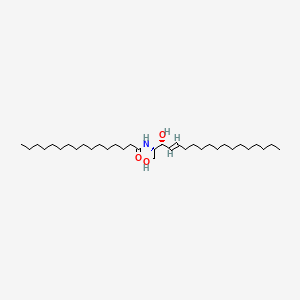| MeSH term | MeSH ID | Detail |
|---|---|---|
| Adenocarcinoma | D000230 | 166 associated lipids |
| Insulinoma | D007340 | 28 associated lipids |
| Colonic Neoplasms | D003110 | 161 associated lipids |
| Leukemia | D007938 | 74 associated lipids |
| Leukemia, Myeloid | D007951 | 52 associated lipids |
N-Palmitoylsphingosine
N-Palmitoylsphingosine is a lipid of Sphingolipids (SP) class. The involved functions are known as ceramide biosynthetic process, Apoptosis, Regulation, Signal Transduction and Caspase-Dependent Apoptosis. N-palmitoylsphingosine often locates in Mitochondria, Membrane, Extracellular and Endoplasmic Reticulum. The associated genes with N-Palmitoylsphingosine are BCL2 gene, cytochrome c'', BCL2L1 gene, LASS6 gene and LASS5 gene. The related lipids are dihydroceramide, Fatty Acids, Sphingolipids, Palmitates and inositolphosphorylceramide.
Cross Reference
Introduction
To understand associated biological information of N-Palmitoylsphingosine, we collected biological information of abnormalities, associated pathways, cellular/molecular locations, biological functions, related genes/proteins, lipids and common seen animal/experimental models with organized paragraphs from literatures.
What diseases are associated with N-Palmitoylsphingosine?
There are no associated biomedical information in the current reference collection.
Possible diseases from mapped MeSH terms on references
We collected disease MeSH terms mapped to the references associated with N-Palmitoylsphingosine
PubChem Associated disorders and diseases
What pathways are associated with N-Palmitoylsphingosine
There are no associated biomedical information in the current reference collection.
PubChem Biomolecular Interactions and Pathways
Link to PubChem Biomolecular Interactions and PathwaysWhat cellular locations are associated with N-Palmitoylsphingosine?
Visualization in cellular structure
Associated locations are in red color. Not associated locations are in black.
Related references are published most in these journals:
| Location | Cross reference | Weighted score | Related literatures |
|---|
What functions are associated with N-Palmitoylsphingosine?
Related references are published most in these journals:
| Function | Cross reference | Weighted score | Related literatures |
|---|
What lipids are associated with N-Palmitoylsphingosine?
Related references are published most in these journals:
| Lipid concept | Cross reference | Weighted score | Related literatures |
|---|
What genes are associated with N-Palmitoylsphingosine?
Related references are published most in these journals:
| Gene | Cross reference | Weighted score | Related literatures |
|---|
What common seen animal models are associated with N-Palmitoylsphingosine?
There are no associated biomedical information in the current reference collection.
NCBI Entrez Crosslinks
All references with N-Palmitoylsphingosine
Download all related citations| Authors | Title | Published | Journal | PubMed Link |
|---|---|---|---|---|
| pmid: | ||||
| Bao JX et al. | Triggering role of acid sphingomyelinase in endothelial lysosome-membrane fusion and dysfunction in coronary arteries. | 2010 | Am. J. Physiol. Heart Circ. Physiol. | pmid:20061541 |
| Gorgoglione V et al. | Ceramide-induced activation of cytosolic NADH/cytochrome c electron transport pathway: An additional source of energy for apoptosis. | 2010 | Arch. Biochem. Biophys. | pmid:20850412 |
| Deroyer C et al. | New role for EMD (emerin), a key inner nuclear membrane protein, as an enhancer of autophagosome formation in the C16-ceramide autophagy pathway. | 2014 | Autophagy | pmid:24819607 |
| Grassmé H et al. | Molecular mechanisms of ceramide-mediated CD95 clustering. | 2001 | Biochem. Biophys. Res. Commun. | pmid:11409897 |
| Bock J et al. | Ceramide inhibits the potassium channel Kv1.3 by the formation of membrane platforms. | 2003 | Biochem. Biophys. Res. Commun. | pmid:12767914 |
| Hinz B et al. | R(+)-methanandamide-induced cyclooxygenase-2 expression in H4 human neuroglioma cells: possible involvement of membrane lipid rafts. | 2004 | Biochem. Biophys. Res. Commun. | pmid:15474472 |
| Tserng KY and Griffin RL | Ceramide metabolite, not intact ceramide molecule, may be responsible for cellular toxicity. | 2004 | Biochem. J. | pmid:14998372 |
| Beverly LJ et al. | BAK activation is necessary and sufficient to drive ceramide synthase-dependent ceramide accumulation following inhibition of BCL2-like proteins. | 2013 | Biochem. J. | pmid:23480852 |
| Fillet M et al. | Mechanisms involved in exogenous C2- and C6-ceramide-induced cancer cell toxicity. | 2003 | Biochem. Pharmacol. | pmid:12754099 |
